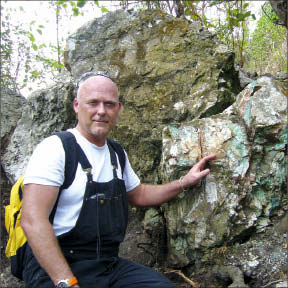At long last, Ottawa-based Majescor Resources (MJX-V) has received high-grade gold assays from drilling completed in December 2009 at its Somine gold-copper project in northeastern Haiti.
According to Majescor, analyses and results were delayed due to the January 2010 earthquake in Port-au-Prince, though “care has been taken to ensure that the samples were properly stored, accounted and retrieved before shipment to a reputable laboratory facility, Acme Analytical Laboratories of Vancouver, B.C.”
The drill results are from the company’s first-phase, 1,000-metre program in 2009 targeting the Faille B prospect.
Prior to the drill program, Faille B last saw a drill bit in 1987 as part of an exploration campaign carried out by the United Nations, which delineated a small non-National Instrument 43-101-compliant gold resource there.
Of the nine holes Majescor completed to test extensions of the historic zone, a few returned decent grades from a gold vein that has been defined from a depth of 20 metres to 102 metres. The best result, 10.5 metres grading an uncut 77 grams gold and 0.17% copper, can mostly be attributed to a smaller 1.5-metre section grading 537 grams gold and 0.21% copper.
According to a tool called the Drill Hole Interval Calculator created by Exploration Insights newsletter writer and geologist Brent Cook, the remaining 9 metres have a residual grade of 0.33 gram gold and 0.16% copper.
The next best result was 6 metres grading 3 grams gold, starting from a depth of 57.5 metres.
Majescor controls an approximate 65.5% interest in the property through a series of arrangements with Haitian-American business partners.
Holding title to the project is a Haitian company named Somine SA. Before Majescor acquired its interest, Somine was mostly controlled by New York City-based investment house Simact, which invests in tourist resorts, agriculture, banking and mining in Haiti.
Majescor bought a 100% interest in Simact’s Montreal-based mining enterprise, Simact Alliance Copper Gold, which controls around 60% of the voting rights to Somine. Majescor later acquired another 5.5% interest privately.
The earthquake did not directly impact the Somine property, according to the company’s regulatory filings on SEDAR, as it is situated in Haiti’s northeast corner, a 250-km drive from the capital Port-au-Prince and the epicenter of the quake.
However, one senior Somine employee was killed and most of Somine’s accounting records were lost.
Faille B is situated within a 10-km-long by up to 3.8-km-wide copper-bearing corridor defined by previous operators through regional stream sediment, soil and rock geochemistry sampling, as well as drilling and trenching.
The corridor includes the Blondin and Douvray copper-gold zones, for which historical, non-compliant resource estimates exist.
At Blondin, eight holes drilled by the United Nations in the 1970s identified a potential 50 million tonnes grading 0.56% copper, using a 0.3% copper cut-off grade.
Douvray, meanwhile, was tested by about 60 holes from three different operators, including the UN and the West German government in the 1970s, and junior explorer St. Genevieve Resources in the 1990s.
St. Genevieve estimated the eastern part of Douvray contained 69.4 million tonnes grading 0.39% copper, while the western part contained another 29 million tonnes grading 0.33% copper.
As for Faille B, it has a non-compliant historical resource of 1.07 million tonnes grading 2.36 grams gold, or 81,196 oz.
Prior to optioning its interest in the Somine project, Majescor explored for uranium in Quebec and for diamonds across several parts of Canada.
The company is led by Daniel Hachey, a former investment banker who joined long-time directors Marc-André Bernier and Jacques Trottier as president and CEO in early 2010.
Also on the board are two representatives of Majescor’s Haitian-American business partners. They include Jean-Marie Wolff, a banker and real estate vendor in New York, and Daniel Faustin, a medical doctor from New York with business interests in real estate and tourism in Haiti.
According to Majescor’s technical report, the Somine property lies within a highly prospective volcanic arc environment, host to numerous epithermal gold and porphyry copper occurrences in Haiti as well as the world-class Pueblo Viejo gold deposit in the eastern portion of the adjacent Dominican Republic. The latter is jointly owned by Barrick Gold (ABX-T, ABX-N) and Goldcorp (G-T, GG-N).
The other significant mining junior active in Haiti is Littleton, Colorado-based Eurasian Minerals (EMX-V), which controls over 2,810 sq. km of prospecting permits in the country’s northwest and northeast. Newmont Mining (NMC-T, NEM-N) took over as operator of the projects earlier this year.
Shares of Majescor rose as high as 29¢ in intraday trading before closing up 9.5¢ to 23.5¢ on heavy volume of 3.22 million shares after the company released its drill results on Aug. 18.
There are currently 58 million Majescor shares outstanding, 80 million if fully diluted, trading within a 52-week range of 10¢-32¢.


Be the first to comment on "Majescor doubles on Haitian drill results"